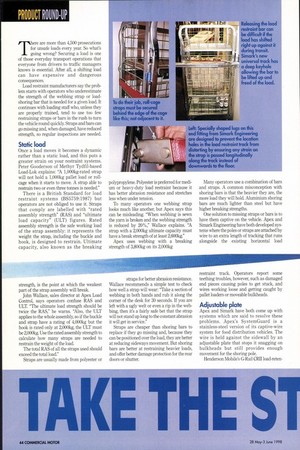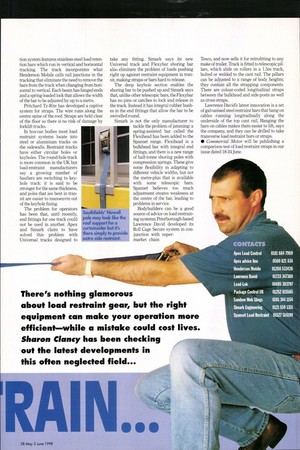• • There are more than 4,500 prosecutions for unsafe
Page 48

Page 49

If you've noticed an error in this article please click here to report it so we can fix it.
loads every year. So what's going wrong? Securing a load is one of those everyday transport operations that everyone from drivers to traffic managers knows is essential. After all, a shifting load can have expensive and dangerous consequences.
Load restraint manufacturers say the problem starts with operators who underestimate the strength of the webbing strap or loadshoring bar that is needed for a given load. It continues with loading staff who, unless they are properly trained, tend to use too few restraining straps or bars in the rush to turn the vehicle round quickly. Straps and bars can go missing and, when damaged, have reduced strength, so regular inspections are needed.
Static load Once a load moves it becomes a dynamic rather than a static load, and this puts a greater strain on your restraint systems. Peter Gooderson of Methyr Tydfil-based Load-Lok explains: "A 1,000kg-rated strap will not hold a 1,000kg pallet load or rollcage when it starts to move. A strap able to restrain two or even three tonnes is needed."
There is a British Standard for load restraint systems (BS5759:1987) but operators are not obliged to use it. Straps that comply are labelled with "rated assembly strength" (RAS) and "ultimate load capacity" (ULT) figures. Rated assembly strength is the safe working load of the strap assembly: it represents the weight the strap, including the buckle and hook, is designed to restrain. Ultimate capacity, also known as the breaking strength, is the point at which the weakest part of the strap assembly will break.
John Wallace, sales director at Apex Load Control, says operators confuse RAS and ULT. "The ultimate load strength should be twice the RAS," he warns. "Also, the ULT applies to the whole assembly, so if the buckle and strap have a rating of 4,000kg but the hook is rated only at 2,000kg, the ULT must be 2,000kg. Use the rated assembly strength to calculate how many straps are needed to restrain the weight of the load.
The total RAS of all the straps used should exceed the total load."
Straps are usually made from polyester or polypropylene. Polyester is preferred for medium or heavy-duty load restraint because it has better abrasion resistance and stretches less when under tension.
To many operators one webbing strap looks much like another, but Apex says this can be misleading. "When webbing is sewn the yarn is broken and the webbing strength is reduced by 20%," Wallace explains. "A strap with a 2,000kg ultimate capacity must have a break strength of at least 2,600kg."
Apex uses webbing with a breaking strength of 3,800kg on its 2,000kg straps for better abrasion resistance. Wallace recommends a simple test to check how well a strap will wear: "Take a section of webbing in both hands and rub it along the corner of the desk for 30 seconds. If you are left with a ugly welt or even a rip in the webbing, then it's a fairly safe bet that the strap will not stand up long to the constant abrasion it will get in service."
Straps are cheaper than shoring bars to replace if they go missing and, because they can be positioned over the load, they are better at reducing sideways movement. But shoring bars are better at restraining heavier loads, and offer better damage protection for the rear doors or shutter. Many operators use a combination of bars and straps. A common misconception with shoring bars is that the heavier they are, the more load they will hold. Aluminium shoring bars are much lighter than steel but have higher breaking strengths.
One solution to missing straps or bars is to have them captive on the vehicle. Apex and Simark Engineering have both developed systems where the poles or straps are attached by wire to an extra length of tracking that runs alongside the existing horizontal load restraint track. Operators report some teething troubles, however, such as damaged end pieces causing poles to get stuck, and wires working loose and getting caught by pallet loaders or moveable bulkheads.
Adjustable plate Apex and Simark have both come up with systems which are said to resolve these problems. Apex's SystemGuard is a stainless-steel version of its captive-wire system for food distribution vehicles. The wire is held against the sidewall by an adjustable plate that stops it snagging on bulkheads but still provides enough movement for the shoring pole.
Henderson Mobile's G-Rail CRII load-reten tion system features stainless-steel load retention bars which run in vertical and horizontal tracking. The track incorporates what Henderson Mobile calls rail junctions in the tracking that eliminate the need to remove the bars from the track when changing from horizontal to vertical. Each beam has hinged ends and a spring-loaded lock that allows the width of the bar to be adjusted by up to a metre.
Pritchard Ty-Rite has developed a captive system for straps. The wire runs along the centre spine of the roof. Straps are held clear of the floor so there is no risk of damage by forklift trucks.
In boxvan bodies most load restraint systems locate into steel or aluminium tracks on the sidewalls. Restraint tracks have either circular holes or keyholes. The round-hole track is more common in the UK but load-restraint manufacturers say a growing number of hauliers are switching to keyhole track: it is said to be stronger for the same thickness, and poles that are bent in transit are easier to manoeuvre out of the keyhole fixing.
The problem for operators has been that, until recently, end fittings for one track could not be used in another. Apex and Simark claim to have solved this problem with Universal tracks designed to take any fitting. Simark says its new Universal track and Flexybar shoring bar also eliminate the problem of loads pushing right up against restraint equipment in transit, making straps or bars hard to release.
The deep keyhole section enables the shoring bar to be pushed up and Simark says that, unlike other telescopic bars, the Flexybar has no pins or catches to lock and release in the track. Instead it has integral rubber bushes in the end fittings that allow the bar to be swivelled round.
Simark is not the only manufacturer to tackle the problem of jamming a spring-assisted bar called the Flexihead has been added to the Spanset range. Flexihead is a bulkhead bar with integral end fittings, and there is a new range of half-tonne shoring poles with compression springs. These give some flexibility in adapting to different vehicle widths, but not the metre-plus that is available with some , telescopic bars. Spanset believes too much adjustment creates weakness at the centre of the bar, leading to problems in service.
Bodybuilders can be a good source of advice on load-restraining systems; Peterborough-based Lawrence David developed its Roll Cage Secure system in conjunction with supermarket chain Tesco, and now sells it for retrofitting to any make of trailer. Track is fitted to telescopic pillars, which slide on rollers in a 1.5m track, bolted or welded to the cant rail. The pillars can be adjusted to a range of body heights; they contain all the strapping components. There are colour-coded longitudinal straps between the bulkhead and side-posts as well as cross straps.
Lawrence David's latest innovation is a set of galvanised steel restraint bars that hang on cables running longitudinally along the underside of the top cant rail. Hanging the bars on cables makes them easier to lift, says the company, and they can be drilled to take transverse load restraint bars or straps.
• Commercial Motor will be publishing a comparison test of load restraint straps in our issue dated 18-24 June.






















































































































